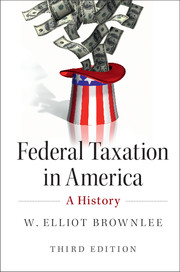Book contents
- Frontmatter
- Dedication
- Contents
- Figures
- Preface
- Acknowledgments
- 1 Anglo-American Regimes
- 2 Creating a Modern Fiscal State
- 3 The Civil War Regime
- 4 The World War I Regime
- 5 Roosevelt's Regimes
- 6 The Era of Easy Finance
- 7 “Reagan Revolution”
- 8 Fiscal Consolidation and Revival of the Old Tax Regime
- 9 Victory for a Retro-Liberal Regime
- 10 Fiscal Paralysis
- Appendix
- Historiography and Bibliography
- Index
2 - Creating a Modern Fiscal State
Published online by Cambridge University Press: 05 July 2016
- Frontmatter
- Dedication
- Contents
- Figures
- Preface
- Acknowledgments
- 1 Anglo-American Regimes
- 2 Creating a Modern Fiscal State
- 3 The Civil War Regime
- 4 The World War I Regime
- 5 Roosevelt's Regimes
- 6 The Era of Easy Finance
- 7 “Reagan Revolution”
- 8 Fiscal Consolidation and Revival of the Old Tax Regime
- 9 Victory for a Retro-Liberal Regime
- 10 Fiscal Paralysis
- Appendix
- Historiography and Bibliography
- Index
Summary
The ratification of the U.S. Constitution in 1788 created the basic structure of federal taxation. The new Constitution established powers and requirements that have had an enduring influence on all the nation's tax regimes. The Constitution gave the new federal government clear and broad powers to impose “indirect” taxes – taxes on commerce that consumers would pay only indirectly, through intermediaries – as well as the power to borrow and the exclusive power to create money. But the Constitution restricted the ability to levy “direct” taxes – taxes levied directly on individuals. This restriction had a major impact on the form of all federal tax regimes and on the division of tax effort between the federal government and the governments of states and localities.
The framers of the Constitution provided only the skeleton of a state. It was up to the leaders of the new republic to develop the central instruments of government, including government finance. Beginning in the 1790s these leaders experimented with many of the taxes allowed by the Constitution, but they made extensive use only of taxes on imports. They discovered that import duties met most of their needs for tax revenues while minimizing political discord. As in Britain, low customs duties formed the core of the nation's financial system, funding important national projects directly and also paying the interest required to carry national debt. The tax regime lasted until the Civil War, surviving longer than any other except the one created during World War II.
The new American government had two other key elements, both of which had deep roots and remain significant even today. Their combined effect has been to reduce the need for taxation by the federal government, and this effect was never greater than in the nineteenth century.
One element was heavy taxation by sub-national (state and local) governments. Its importance had much to do with the history of the movement toward American political independence. Before the Revolution, the American colonies had used their discretionary fiscal space within the British Empire to expand their taxation of property and internal trade; the New England and Middle Atlantic colonies had employed these taxes not only to contribute to waging colonial wars but also to fund various public services.
- Type
- Chapter
- Information
- Federal Taxation in AmericaA History, pp. 31 - 57Publisher: Cambridge University PressPrint publication year: 2016
- 1
- Cited by



